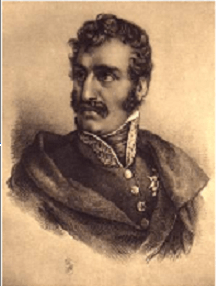Francisco Ballesteros facts for kids
Quick facts for kids
Francisco Ballesteros
|
|
|---|---|
 |
|
| Born | 7 March 1770 Zaragoza |
| Died | 1833 (aged 63) Paris |
Francisco López Ballesteros (born 1770, died 1833) was an important Spanish general. He played a big part in the Peninsular War, fighting against the French.
Contents
Early Military Life
Francisco Ballesteros joined the army in 1788 as a cadet, which is like a trainee officer. He was part of the Volunteers of Aragón. He later moved to a Catalan regiment and became a captain in 1794. He also fought as a captain in the War of the Oranges.
Fighting in the Peninsular War
The Peninsular War (1808–1814) was a major conflict in Spain and Portugal. It was part of the wider Napoleonic Wars, where Spain, Portugal, and the United Kingdom fought against Napoleon's French Empire.
Starting the Fight (1808-1809)
In 1808, Ballesteros was in Madrid during the Dos de Mayo Uprising, a famous revolt against the French. After this, he quickly went to Asturias, a region in northern Spain. There, a local government group called the Junta General del Principado de Asturias made him a field marshal, a high-ranking army officer.
By March 1809, Ballesteros had nearly 10,000 soldiers under his command. He set up his headquarters in Colombres and often had small fights with French troops.
On June 10, 1809, he successfully attacked and took Santander, forcing out the French General Noirot. The French tried to get it back, and on June 12, General Bonet attacked with a large force. Ballesteros's division was defeated. Ballesteros and another officer, José O'Donnell, managed to escape by sea. However, 3,000 of his men were captured, and many others scattered.
In July 1809, he traveled by ship from Gijón to La Coruña. From there, he moved south through Castile to Andalucía. In the autumn of 1809, Ballesteros led the 3rd Division of the Duke del Parque's army. This was the largest division, with over 9,600 men. They fought in battles at Tamames (October 18) and Alba de Tormes (November 28).
Continued Battles (1810-1811)
In February 1810, Ballesteros surprised a French cavalry group at Valverde. He later led several operations against French forces in Andalusia. His division was sent to bother Marshal Soult's French army.
In March and April 1810, his troops had a small fight with a French brigade. Ballesteros then pulled back into the hills. He fought at El Villar in April. On April 15, he was defeated at Zalamea by a French division. The French chased him through the mountains and defeated him again at Aracena on May 26.
In January 1811, Ballesteros's 5,000 men had a running fight with French troops around Calera, Monesterio, and Fregenal. They managed to avoid serious harm. At Castillejos later that month, French troops forced him to retreat into Portugal.
In March 1811, Ballesteros returned to Spain from Portugal. Leading 4,000 troops, he defeated General Rémond near the Rio Tinto. A week later, on March 9, Ballesteros surprised Rémond again at La Palma, capturing two cannons and pushing the French back to Seville. Because of his successes, he was promoted to lieutenant general in 1811.
On April 12, 1811, Ballesteros's division, with about 3,500 soldiers, was beaten by French infantry at Fregenal. He also commanded Spanish divisions alongside other generals at the Battle of Albuera on May 16, 1811.
Later in 1811, Ballesteros landed at Algeciras. Several French battalions, totaling about 10,000 troops, were sent to hunt him down. Despite this, Ballesteros managed to cause problems for the French. When the French columns had to withdraw due to lack of supplies, he attacked their rear guard. He defeated General Semellé at the first battle of Bornos on November 5.
In December, Ballesteros attacked a French battalion near the pass of Ojen. When a larger French force returned to fight, the Spanish troops retreated to San Roque.
Commander and Dismissal (1812)
In April 1812, Ballesteros tried to capture the Castle of Zahara but failed. A few days later, one of his groups entered Osuna but left after failing to take its fortress and hearing that French forces were coming. On April 14, at Alhaurin, he stopped three French battalions that were going to help the garrison at Ronda. He captured their two cannons and forced them back to Malaga.
Ballesteros was made commander-in-chief of the 4th Army in August 1812. However, he was unwilling to accept Wellington, a British general, as the supreme commander of the Spanish Army. Because of this disagreement, Ballesteros was removed from his position on December 12 and later imprisoned in Ceuta, a Spanish city on the North African coast.
After the War
In 1815, King Fernando VII appointed Ballesteros as the Minister for War. However, the king later dismissed him and sent him away to Valladolid.
The Liberal Revolution
When a liberal revolution began in 1820, Ballesteros was called back to Madrid. On March 7, he was made commander-in-chief of the Army of the Centre. Two days later, he became vice-president of a temporary governing group. He helped close many prisons of the Holy Inquisition and brought back local government rights.
On July 7, 1822, Ballesteros defeated the Royal Guards, stopping an attempt to overthrow the new Constitution. For this, he was named Captain General of Madrid. In 1823, he fought against the French invasion in Navarra and Aragón. However, he had to surrender on August 21, 1823.
On October 1, 1823, King Fernando VII began to punish everyone who had supported the constitutional government. Ballesteros fled to Cádiz and then sailed on a British ship to France. He lived the rest of his life in Paris, where he passed away in 1833.
See also
 In Spanish: Francisco Ballesteros para niños
In Spanish: Francisco Ballesteros para niños

